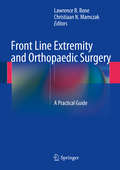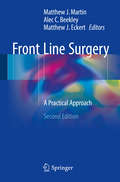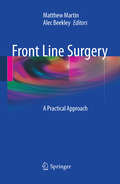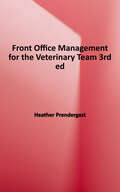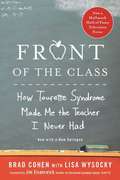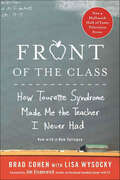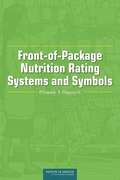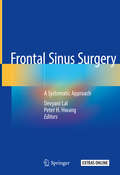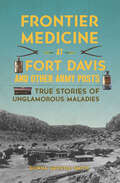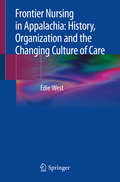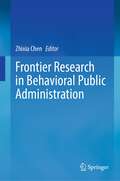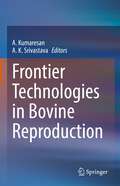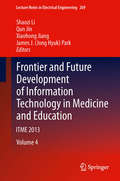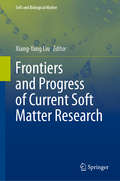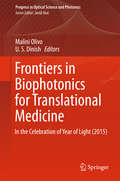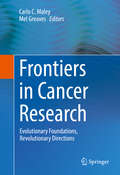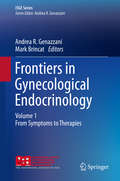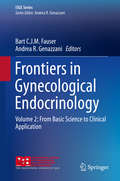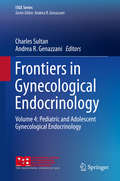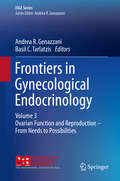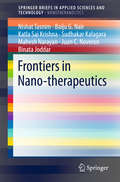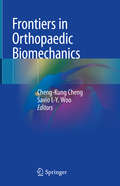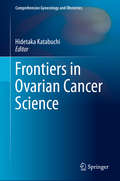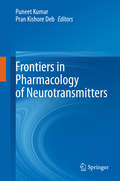- Table View
- List View
Front Line Extremity and Orthopaedic Surgery
by Lawrence B. Bone Christiaan N. MamczakThis is an easy to read reference and practical guide to the management of combat extremity injuries, which account for a high percentage of the injuries sustained in recent and current conflicts. The surgical techniques appropriate to the full range of extremity injuries and some other frequent injuries, such as trauma to the spine and pelvis, are clearly described with the aid of helpful illustrations. In each chapter a "bottom line up front" approach is adopted, providing key messages first; a further important feature is the emphasis placed on case-based information and lessons learned from practice. Care has been taken to ensure that the advice provided is straightforward and in line with military clinical practice guidelines. This book, written by surgeons with experience in combat casualty care, will be relevant to all physicians working in forward surgical teams, combat surgical hospitals, or the "Charlie Med".
Front Line Surgery
by Matthew J. Martin Alec C. Beekley Matthew J. EckertThe second edition of Front Line Surgery expands upon the success of the first edition, providing updated discussion of practical management of commonly encountered combat injuries. This edition reflects the cutting edge of combat casualty care, refined principles of surgical management of specific injury patterns, and incorporation of the spectrum of recent research advancements in trauma care. Each chapter continues to follow the same organization as the first edition. The "BLUF", or bottom line up front, headlines each topic, providing the critical pearls for the reader, followed by a focused and straight forward discussion of management, pitfalls, and recommendations. In addition, select chapters conclude with a section discussing the application of this topic in civilian practice, as potentially encountered by the rural or humanitarian relief surgeon. Additional new topics include: REBOA and endovascular techniques for hemorrhage control, updates in transfusion and resuscitation practice, active shooter situations, rural trauma management in developed nations, advancements in prehospital care and the Tactical Combat Casualty Care (TC3) course, and discussion of the newest generations of topical hemostatic agents and tourniquets. These additions serve to both enhance the breadth and depth of the material relevant to military surgeons, but should also further expand the applicability and interest in this work to all civilian trauma surgeons.
Front Line Surgery
by Alec C. Beekley, MD, FACS Matthew J. Martin, MD, FACSBoth editors are active duty officers and surgeons in the U.S. Army. Dr. Martin is a fellowship trained trauma surgeon who is currently the Trauma Medical Director at Madigan Army Medical Center. He has served as the Chief of Surgery with the 47th Combat Support Hospital (CSH) in Tikrit, Iraq in 2005 to 2006, and most recently as the Chief of Trauma and General Surgery with the 28th CSH in Baghdad, Iraq in 2007 to 2008. He has published multiple peer-reviewed journal articles and surgical chapters. He presented his latest work analyzing trauma-related deaths in the current war and strategies to reduce them at the 2008 annual meeting of the American College of Surgeons. Dr. Beekley is the former Trauma Medical Director at Madigan Army Medical Center. He has multiple combat deployments to both Iraq and Afghanistan, and has served in a variety of leadership roles with both Forward Surgical Teams (FST) and Combat Support Hospitals (CSH).
Front Office Management for The Veterinary Team: 3rd Edition
by Heather PrendergastLearn to navigate the day-to-day skills you need to be a valuable member of the veterinary office team! Front Office Management for the Veterinary Team, 3rd Edition covers veterinary office duties ranging from: scheduling appointments to billing and accounting, managing inventory and medical records, marketing, using outside diagnostic laboratory services, and communicating effectively and compassionately with clients. This edition includes two all-new chapters on strategic planning and leadership, updated coverage of office procedures, veterinary ethics, and technology. In addition, this complete guide to veterinary practice management features step-by-step instructions, making it easier for you to master vital front-office tasks!
Front Office Management for the Veterinary Team
by Heather PrendergastThe only book of its kind, Front Office Management for the Veterinary Team focuses on the day-to-day duties of the veterinary team. It offers a complete guide to scheduling appointments, billing and accounting, communicating effectively and compassionately with clients, managing medical records, budgeting, marketing your practice, managing inventory, using outside diagnostic laboratory services, and much more. Written by Heather Prendergast, RVT, CVPM, this manual simplifies essential tasks with step-by-step instructions! Exercises on the Evolve website offer additional practice with front office tasks. Interactive working forms give you experience completing sample checks, deposit slips, patient history forms, and incident reports. The latest information on electronic banking and tax forms ensures that you adhere to the most current financial guidelines. What Would You Do/Not Do boxes provide scenarios to expose you to real-life situations that occur in veterinary practice and guide you through to an appropriate resolution. Review questions test your understanding of concepts presented in each chapter. Practice Point boxes highlight practical information to remember while on the job. Veterinary Practice and the Law boxes provide essential information about laws that you must know in order to run an ethical practice and to protect the practice. Key terms and learning objectives guide you through study of the most important content.
Front of the Class: How Tourette Syndrome Made Me the Teacher I Never Had
by Brad Cohen Lisa WysockyAs a child with Tourette syndrome, Brad Cohen was ridiculed, beaten, mocked, and shunned. Children, teachers, and even family members found it difficult to be around him. As a teen, he was viewed by many as purposefully misbehaving, even though he had little power over the twitches and noises he produced, especially under stress. Even today, Brad is sometimes ejected from movie theaters and restaurants. But Brad Cohen's story is not one of self-pity. His unwavering determination and fiercely positive attitude conquered the difficulties he faced in school, in college, and while job hunting. Brad never stopped striving, and after twenty-four interviews, he landed his dream job: teaching grade school and nurturing all of his students as a positive, encouraging role model.
Front of the Class: How Tourette Syndrome Made Me the Teacher I Never Had
by Brad Cohen Lisa WysockyThe inspirational story of how one man overcome his challenges with Tourette syndrome to become Georgia’s First Class Teacher of the Year.As a child with Tourette syndrome, Brad Cohen was ridiculed, beaten, mocked, and shunned. Children, teachers, and even family members found it difficult to be around him. As a teen, he was viewed by many as purposefully misbehaving, even though he had little power over the twitches and noises he produced, especially under stress. Even today, Brad is sometimes ejected from movie theaters and restaurants.But Brad Cohen’s story is not one of self-pity. His unwavering determination and fiercely positive attitude conquered the difficulties he faced in school, in college, and while job hunting. Brad never stopped striving, and after twenty-four interviews, he landed his dream job: teaching grade school and nurturing all of his students as a positive, encouraging role model. Now a Hallmark Hall of Fame Movie Event available on streaming platformsFront of the Class is now in e-book format for the first time and includes a new epilogue.
Front-of-Package Nutrition Rating Systems and Symbols: Phase I Report
by Institute of Medicine of the National AcademiesThe federal government requires that most packaged foods carry a standardized label--the Nutrition Facts panel--that provides nutrition information intended to help consumers make healthful choices. In recent years, manufacturers have begun to include additional nutrition messages on their food packages. These messages are commonly referred to as 'front-of-package' (FOP) labeling. As FOP labeling has multiplied, it has become easy for consumers to be confused about critical nutrition information. In considering how FOP labeling should be used as a nutrition education tool in the future, Congress directed the Centers for Disease Control and Prevention to undertake a two-phase study with the IOM on FOP nutrition rating systems and nutrition-related symbols. The Food and Drug Administration is also a sponsor. In Phase 1 of its study, the IOM reviewed current systems and examined the strength and limitations of the nutrition criteria that underlie them. The IOM concludes that it would be useful for FOP labeling to display calorie information and serving sizes in familiar household measures. In addition, as FOP systems may have the greatest benefit if the nutrients displayed are limited to those most closely related to prominent health conditions, FOP labeling should provide information on saturated fats, trans fats, and sodium.
Frontal Sinus Surgery: A Systematic Approach
by Devyani Lal Peter H. HwangThis state-of-the-art text addresses surgery of the frontal sinus, andthe challenges that come along with it. It provides a comprehensiveoverview of the anatomy of the frontal sinus and a systematic methodof approaching and executing sinus surgery, as well as tools, tips, andstrategies in optimizing success. Additional chapters include themanagement of acute and chronic frontal sinus inflammation, traumaof the frontal sinus, tumors in the frontal sinus, and pediatric frontalsurgery. Perioperative care and management of complications are alsodiscussed. Chapters are richly illustrated with fi gures and surgicalvideos, replete with practical pearls and tips. Frontal Sinus Surgery: A Systematic Approach will be an invaluableresource for general otolaryngologists and rhinologists interested inthe frontal sinus.
Frontier Medicine at Fort Davis and Other Army Posts: True Stories of Unglamorous Maladies
by Donna Gerstle SmithFrom a headless burial to cocaine toothache drops, the true stories hidden in the Wild West's medical records are a match for its tallest tales.In the 19th century, when dying young was a fact of life, a routine bout of diarrhea could be fatal. No one had heard of viruses or bacteria, but they killed more soldiers on the frontier than hostile raiding parties. Physicians dispensed whiskey for TB, mercury for VD and arsenic for indigestion. Baseball injuries were considered to be in the line of duty and twice resulted in amputations at Fort Davis. Donna Gerstle Smith explains how an industrious laundress could earn more than a private, how a female army surgeon won the Medal of Honor and how a garrison illegally hung the local bartender.
Frontier Nursing in Appalachia: History, Organization and the Changing Culture of Care
by Edie WestThis book provides a historical analysis of the Frontier Nursing Services in the Eastern Appalachians of the United States, as well as a review of the oral history tradition of former frontier and non-frontier nurses. The data was gathered from 2003 to 2007, and the historical part covers the years 1900 to 1970. The objective of the study presented here was to conduct interviews with former frontier and non-frontier nurses in order to better understand their family and personal relationships, and the experiences that motivated their career choices. These interviews also give a voice to the working and middle-class women of the FNS. The emerging themes include moral inhabitability in work/education environments, the generational mix, nurse-physician and male-female relationships at the workplace, the role of technology, humanitarian versus financial rewards, and the public image of nurses. In addition, the book examines how the FNS shifted from a community/grass-roots structure to the corporate/business model of healthcare delivery employed today. In closing, it stresses the importance of explorig past nursing in order to better grasp present nursing. It also represents a testament to the professional work and vital contributions of frontier nurses.
Frontier Research in Behavioral Public Administration
by Zhixia ChenThis book mainly summarizes and analyzes the advanced research progress in the field of behavioral public administration, and also looks forward to the future of related academic research. It helps readers to quickly grasp the frontiers and latest developments in the field of behavioral public administration. It is benefit for readers to learn the hot topics, issues, and research methods, improving their research ability. It not only includes the frontier progress in western culture but also includes the researches in China.
Frontier Technologies in Bovine Reproduction
by A. Kumaresan A. K. SrivastavaThis book details the frontier technologies in the area of bovine reproduction. It describes the importance and significance of different technologies for improving reproduction efficiency in bovines. The book delineates the advancements in the technologies that are currently in use for faster multiplication of elite germ plasm including multiple ovulation and embryo transfer, ovum-pick-up, in vitro fertilization and embryo production, and semen sexing. Other emerging technologies, having potential for improving reproductive efficiency in bovines, including stem cells are also discussed with special reference to spermatogonial stem cells. Simple but effective tools having a great scope for day-to-day application in bovine farms for effective reproductive management like ultrasonography and thermal imaging are also covered in this book. The chapters on sperm transcriptomics, proteomics, metabolomics provide current developments in these areas and use of integrated approach for identification of fertility biomarkers. The chapters also describe technological advancements for early pregnancy diagnosis and offspring sex pre-selection in bovines. Additionally, this book discusses different sperm selection procedures including application of nanotechnology to obtain superior spermatozoa for assisted reproduction. Futuristic technologies including genomic selection and transgenesis are also discussed in detail. Finally, the book also elucidates a comprehensive description of challenges perceived with bovine reproduction and how effectively these technologies can help in improving fertility in bovines.
Frontier and Future Development of Information Technology in Medicine and Education
by James J. Jong Hyuk Park Shaozi Li Qun Jin Xiaohong JiangIT changes everyday's life, especially in education and medicine. The goal of ITME 2013 is to further explore the theoretical and practical issues of IT in education and medicine. It also aims to foster new ideas and collaboration between researchers and practitioners.
Frontiers and Progress of Current Soft Matter Research (Soft and Biological Matter)
by Xiang-Yang LiuThis book covers some fundamental aspects and frontiers in non-equilibrium physics and soft matter research. Apart from the basic knowledge on nonlinear statistic physics, dynamics, computer simulations, and main approaches and emerging systems in soft matter research, particular attention is devoted to new conceptual flexible functional materials and the enriching areas, such as silk meso-molecular materials, molecular gels, liquid crystals, flexible electronics and new types of catalysis, etc. One of the main characteristics of this book is to start with the structure formation dynamics and the correlation between the structures and macroscopic performance. This lays down the foundation for the mesoscopic materials design and functionalization. The book is intended for upper undergraduate students, graduate students, and researchers who are interested in soft matter researches. As one of main references, the basic principles and technologies of computer simulations and experimental methods adopted in soft matter research are also explained. Illustrations and tables are included in this book to improve the readability, and examples and exercises are added to help understanding.
Frontiers in Biophotonics for Translational Medicine
by Malini Olivo U. S. DinishThe present book provides recent developments in various in vivo imaging and sensing techniques such as photo acoustics (PA) imaging and microscopy, ultrasound-PA combined modalities, optical coherence tomography (OCT) and micro OCT, Raman and surface enhanced Raman scattering (SERS), Fluorescence lifetime imaging (FLI) techniques and nanoparticle enabled endoscopy etc. There is also a contributing chapter from leading medical instrumentation company on their view of optical imaging techniques in clinical laparoscopic surgery. The UN proclaimed 2015 as the International Year of Light and Light-based Technologies, emphasizing achievements in the optical sciences and their importance to human beings. In this context, this book focusses on the recent advances in biophotonics techniques primarily focused towards translational medicine contributed by thought leaders who have made cutting edge developments in various photonics techniques.
Frontiers in Cancer Research
by Carlo C. Maley Mel GreavesThis is the ideal book for anyone contemplating starting a career in, or shifting their career to, studying the dynamics that drive cancer progression and its response to therapy. Topics include the theory and population genetics of cancers, genetic diversity within tumors (intra-tumor heterogeneity), understanding how mutant clones expand in tissues, the role of cancer stem cells in the dynamics of tumors, the evolution of metastasis, and how to improve cancer therapy by addressing the evolution of cancers in response to our interventions. There are also chapters on the patterns of cancer susceptibility in humans due to a mismatch between our modern environment and the environment in which our ancestors evolved, as well as a chapter on the evolution of cancer suppression mechanisms that have evolved in different species, particularly the large long-lived animals like elephants and whales that are better at suppressing cancers than humans. This book serves as a primer on the evolutionary and ecological theory of cancer- the framework upon which all the details of cancer may be hung. It is ideal for oncologists and cancer researchers interested in evolutionary theory, and evolutionary biologists and ecologists interested in gaining insights into cancer development and prevention.
Frontiers in Gynecological Endocrinology
by Andrea R. Genazzani Mark BrincatThis volume represents an up-to-date overview on the major areas of gynecological endocrinology, providing the reader with a complete explanation of female endocrine regulation and metabolism and relevant disorders and treatment. It is published within the International Society of Gynecological Endocrinology (ISGE) Series and is based on the 2013 International School of Gynecological and Reproductive Endocrinology Summer Course. The book covers a very wide range of topics - from primary amenorrhea to menopause, from the impact of ovarian surgery on fertility to fertility cryopreservation, from metabolic syndrome and polycystic ovary to premature ovarian failure and from the clinical impact of selective progesterone receptor modulators to the use of progesterone in prevention of premature labor. It will be an important tool for obstetricians and gynecologists, endocrinologists and experts in women's health as well as interested GPs.
Frontiers in Gynecological Endocrinology
by Andrea R. Genazzani Bart C. J. M. FauserThis volume offers an up-to-date overview on the major areas of gynecological endocrinology, presenting the latest advances in adolescent gynecological endocrinology, assisted reproduction, menstrual-related disorders, sexuality and transsexualism, polycystic ovary syndrome, myometrial pathology and adenomyosis, obesity and metabolic syndrome, hormonal contraception, premature ovarian failure and menopause. In each chapter the recent advances deriving from basic science and clinical investigations are related to the practical management of the condition under consideration, taking into account the need for individualized therapies. The book is published within the ISGE Book Series, a joint venture between the International Society of Gynecological Endocrinology and Springer and is based on the 2014 International School of Gynecological and Reproductive Endocrinology Winter Course. It will be an important tool for obstetricians and gynecologists, endocrinologists and experts in women's health as well as interested GPs.
Frontiers in Gynecological Endocrinology
by Andrea R. Genazzani Charles SultanThis volume provides a comprehensive, up-to-date overview on pediatric and adolescent gynecological endocrinology. It covers a very wide range of topics with a particular focus on disorders of sex differentiation, pubertal maturation, growth disorders, primary and secondary amenorrhea, menstrual disorders in adolescents and young adults, sexuality, contraception, and pregnancy. The authors are international well-known experts who document the latest clinical experience in this continuously evolving field and provide practical guidance on the evaluation and treatment of female pubertal problems. The book is published within the International Society of Gynecological Endocrinology (ISGE) Series and is based on the 2015 International School of Gynecological and Reproductive Endocrinology (ISGRE) Summer Course. It will be an invaluable reference for gynecologists, endocrinologists, pediatricians, and experts in women's health.
Frontiers in Gynecological Endocrinology
by Andrea R. Genazzani Basil C. TarlatzisThis volume represents an up-to-date overview on ovarian functions and reproduction, providing the reader with the latest advances in gynecological endocrinology. It is published within the International Society of Gynecological Endocrinology (ISGE) Series, and is based on the 2015 International School of Gynecological and Reproductive Endocrinology Winter Course. The book covers a very wide range of topics with particular focus on ovulation and assisted reproduction, ovarian aging and fertility, and premature ovarian failure. The volume will be an invaluable tool for gynecologists, endocrinologists, obstetrician, and experts in women's health.
Frontiers in Nano-therapeutics
by Nishat Tasnim Baiju G. Nair Katla Sai Krishna Sudhakar Kalagara Mahesh Narayan Juan C. Noveron Binata JoddarThis brief highlights recent research advances in the area of nano-therapeutics. Nanotechnology holds immense potential for application in a wide range of biological and engineering applications such as molecular sensors for disease diagnosis, therapeutic agents for the treatment of diseases, a vehicle for delivering therapeutics and imaging agents for theranostic applications, both in-vitro and in-vivo. The brief is grouped into the following sections namely, A) Discrete Nanosystems ; B) Anisotropic Nanoparticles; C) Nano-films/coated/layered and D) Nano-composites.
Frontiers in Orthopaedic Biomechanics
by Cheng-Kung Cheng Savio L-Y. WooThis book provides state-of-the-art and up-to-date discussions on the pathology-related considerations and implications in the field of orthopaedic biomechanics. It presents fundamental engineering and mechanical theories concerning the biomechanics of orthopaedic and anatomical structures, and explores the biological and mechanical features that influence or modify the biomechanics of these structures. It also addresses clinically relevant biomechanical issues with a focus on diagnosis, injury, prevention and treatment. The first 12 chapters of the book provide a detailed review of the principles of orthopaedic biomechanics in the musculoskeletal system, including cartilage, bone, muscles and tendon, ligament, and multiple joints. Each chapter also covers important biomechanical concepts relevant to surgical and clinical practice. The remaining chapters examines clinically relevant trauma and injury challenges in the field, including diagnostic techniques such as movement analysis and rehabilitation intervention. Lastly it describes advanced considerations and approaches for fracture fixation, implant design, and biomaterials.
Frontiers in Ovarian Cancer Science
by Hidetaka KatabuchiThis volume presents the latest advances and the current status of our understanding regarding ovarian cancer, addressing both the basic and clinical aspects of the disease. In terms of basic medicine, the WHO Classification of Tumors of Female Reproductive Organs was revised in 2014, and that version addresses several new concepts and histopathological classifications not previously included. One of the most revolutionary breakthroughs concerns the genesis of epithelial ovarian tumors, shifting the focus from the ovarian surface epithelium to serous tubal intraepithelial carcinomas. Clinically, the mortality rate of epithelial ovarian cancer has gradually increased over the past few decades, making it essential to pursue multidisciplinary treatment and apply novel techniques such as neoadjuvant chemotherapy in daily clinical practice. The primary clinical task is the effective treatment of recurrent ovarian cancer with early palliative medicine. Fertility-sparing surgery may also be pursued depending on histologic subtypes, stage, extent of disease, and preexisting ovarian reserve with the concept of oncofertility. On the basis of the considerations described above, each expert author elucidates the science of ovarian cancer in detail, thus providing a collection that will benefit young medical oncologists and seasoned gynecologists and obstetricians alike.
Frontiers in Pharmacology of Neurotransmitters
by Puneet Kumar Pran Kishore DebNumerous phenomenal advances have been made towards understanding the role of neurotransmitters in the pathophysiology of neurological disorders, and these have resulted in a large number of novel molecules with the potential to revolutionize the treatment and prevention of such disorders. This book provides a comprehensive and detailed explanation of brain neurotransmitters and their receptors and associated channels. It includes a basic introduction, and also discusses the functions and recent advances and their pharmacology, highlighting the role of various computer aided drug design (CADD) strategies for the development of therapeutic ligands to modulate these receptors/ion channels. Written in an easy-to-read style, it is intended for neuroscience and pharmaceutical students and researchers working in the area of brain neurotransmitters.
